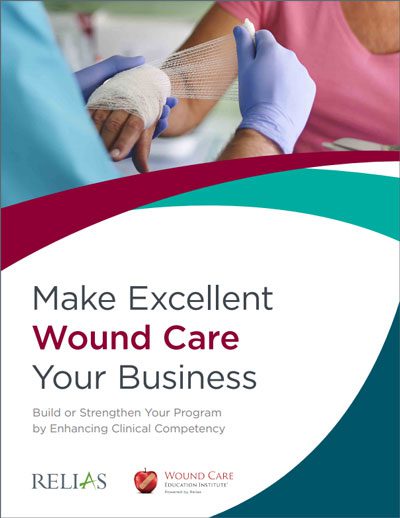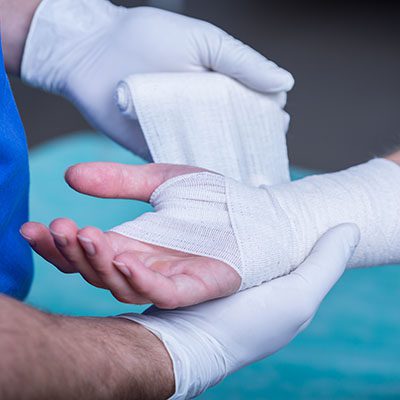Comprehensive wound care documentation is a critical part of day-to-day operations in any medical facility. Not only does it help ensure patients receive the high-quality care they deserve, but it also helps protect those providing care from litigation.
Unfortunately, lawsuits tied to wound care are incredibly common. One of the best ways to protect yourself is to ensure that everyone working at your facility knows how to effectively document wound care. Read on for wound care documentation examples and tips for helping improve your staff’s skill sets so you can protect patients and practitioners alike.
What Is Included in a Wound Assessment?
A wound assessment begins with a thorough examination of a patient’s full body. All wounds must be assessed, measured, and effectively documented at least every seven days. In terms of how to document a wound assessment, more details are always better. Some of the key elements to document are:
- Location: Use the correct anatomical terms to clearly document the wound’s location.
- Type of Wound: Many types of wounds can be assessed and documented, including surgical wounds, burns, and pressure injuries. Wounds can also be acute or chronic.
- Measurement: The size of the wound should be measured in centimeters and listed in the wound care treatment chart as length times width times depth. Nurses must also document the location and depth of any tunneling or undermining.
- Wound Bed: It’s important to document tissue type (slough, eschar, epithelial, granulation, etc.), coloring, and level of adherence using percentages. For example, “40% of the wound is covered in non-adherent tan slough while 60% is covered with red granulation tissue.”
- Wound Edges: Indicate whether a wound’s edges are defined or undefined, attached or unattached, rolled under, macerated, fibrotic, or callused.
- Drainage: The amount and type of drainage must be documented in a wound care assessment. Common types of draining include serous, sanguineous, serosanguineous, and purulent. Words like “none,” “scant,” “small,” “moderate,” and “large/copious” are often used to describe the amount of drainage assessed.
- Odor: Wounds can have different odors, including those that are strong, foul, pungent, fecal, musty, or sweet. Some have no odor at all.
- Surrounding Tissue: Describe the color, firmness, and pallor of the surrounding skin. Note any signs of edema or induration, as well as any lesions, scarring, rashes, staining, moisture, or variations in texture.
- Infection: Wounds are often prone to infection, which can significantly disrupt the healing process. A wound assessment should cite any indicators of infection, including redness or localized pain.
- Pain: A comprehensive wound assessment describes a patient’s pain in detail, noting its location and intensity as well as any patterns and variations in pain type. Common pain descriptors include throbbing, stabbing, burning, pulsing, pounding, pricking, hot, tingling, stinging, cramping, beating, gnawing, dull, tight, squeezing, piercing, and electrical. The assessment should also address possible causative and alleviating factors, including any interventions that were taken.
- Response to Care/Treatment Plan: It’s important to document whether the wound has improved and to list any evidence of healing. Nurses will also need to document any pain the patient experiences when the wound dressing is changed as well as any examples of an adverse reaction. If the patient has not been adhering to treatment plans, that should be noted in the assessment.
How Do You Document a Wound Assessment Properly?
A thorough wound care treatment chart helps the entire treatment team stay up to date on a patient’s progress. Here are a few wound care documentation samples and tips to ensure your team is documenting wounds effectively:
1. Measure Consistently
Use the body as a clock when documenting the length, width, and depth of a wound using the linear method. In all instances of the linear (or clock) method, the head is at 12:00 and the feet are at 6:00. When measuring length, the ruler will be placed between the longest portion of the wound between 12:00 and 6:00. The width is measured at the widest part of the wound between 3:00 and 9:00.
Measuring depth is a little more challenging. This can be accomplished by gently placing a cotton-tip applicator into the deepest part of the wound, then holding the applicator up to a ruler. This same applicator can be used to measure tunneling and undermining. Because undermining spreads in many directions, the linear method should be used to document multiple measurements. For example, a nurse may describe the wound’s undermining as “0.5 cm between 1:00 and 2:00 and 1.5 cm between 2:00 and 5:00.”
2. Grade Appropriately
Edema, or swelling, can vary in severity depending on the patient and the wound. Some will experience significant swelling, while others may have little or none. Edema can be documented using a simple, yet effective, grading system that rates its severity on a scale of one to four.
To use this system, healthcare professionals must apply pressure to the affected area for five seconds, then release. The grade of the edema is determined by the depth of the depression that is left: grade one indicates a 2-mm depression that rebounds quickly, grade two describes a 4-mm depression that takes a few seconds to rebound, grade three pertains to a 6-mm depression that lasts for 10 to 12 seconds, and grade four signifies an 8-mm depression that lasts for 20 seconds.
3. Get Specific
Lawyers and the medical personnel they hire often look for certain keywords that can be used to question a clinician’s treatment. The term “packed” is a common example of a wound assessment documentation term often used in healthcare facilities and in the courthouse. If a wound gets worse or fails to heal, lawyers may argue that the clinician packed the wound too tightly, causing additional damage.
Instead of using the word “packed,” a more accurate wound care charting sample would say, “filled the wound loosely.” This type of specificity leaves less room for misinterpretation and accusations of wrongdoing.
Empower Your Team to Become Wound Care Experts
Wound care documentation has the power to elevate your facility’s standard of care and protect your team from undue legal charges.
But proper wound care documentation takes effort. Learn more about how to build or strengthen your organization’s wound care expertise in our e-Book, Make Excellent Wound Care Your Business.

Strengthen your wound care expertise
Learn more about how to build or strengthen your organization's wound care expertise in our e-book: Make Excellent Wound Care Your Business.
Download the E-Book →






